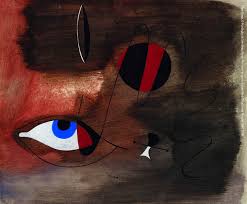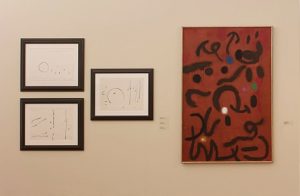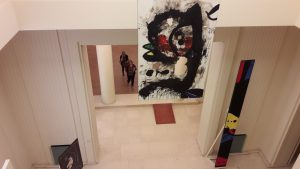 There are so many reasons to choose Padua for an unforgettable city break, but I invite you to leave out the great Prato della Valle, Palazzo della Ragione and the nearby squares for just a moment and follow me into the discovery of an original art show dedicated to Joan Miró. While approaching Palazzo Zabarella, where the exhibition takes place, I’ll share why I find that it’s an unforgettable and energising event.
There are so many reasons to choose Padua for an unforgettable city break, but I invite you to leave out the great Prato della Valle, Palazzo della Ragione and the nearby squares for just a moment and follow me into the discovery of an original art show dedicated to Joan Miró. While approaching Palazzo Zabarella, where the exhibition takes place, I’ll share why I find that it’s an unforgettable and energising event.
Joan Miró (1893-1983) was an extraordinary Catalan artist of the 20th century, an important exponent of Surrealism and a constant innovator. The senses and spontaneity, nature and the simple things inspired his painting. This is evident in the Miró Collection on exhibition in Padua.
 The Collection is composed of 85 pieces (paintings, sculptures, sobreteixims, collages and drawings) which span from 1924 to 1981. The singularity of the Collection is also due to the fact that it has now left Portugal for the first time and allows us to learn something more about the evolution of Miró’s creativity and the characters of his universe (women, birds, constellations, eight-pointed star).
The Collection is composed of 85 pieces (paintings, sculptures, sobreteixims, collages and drawings) which span from 1924 to 1981. The singularity of the Collection is also due to the fact that it has now left Portugal for the first time and allows us to learn something more about the evolution of Miró’s creativity and the characters of his universe (women, birds, constellations, eight-pointed star).
The chosen theme, “Materiality and Metamorphosis”, puts the visitor in front of a series of growing personal artistic experiments. On the one hand, Miró was trying to keep equilibrium, and on the other, he was involved in the process of simplification and subtraction of his characters. That’s the main reason why he was defined as a painter and an anti-painter at the same time. His stays in Paris, New York and Japan played a crucial role in his education, as well as the artists he met (P. Picasso, A. Breton, T. Tzara, M. Ernst, P. Jackson Pollock).
 The relation between the sources and the techniques he applied is peculiar. They both are linked to the moods they caused when combined in different ways. However, Miró left nothing to fate and every mark was studied and determined meticulously. As an example, I suggest to stop and look at “Toile brûlée”, created for Grand Palais of Paris in 1974.
The relation between the sources and the techniques he applied is peculiar. They both are linked to the moods they caused when combined in different ways. However, Miró left nothing to fate and every mark was studied and determined meticulously. As an example, I suggest to stop and look at “Toile brûlée”, created for Grand Palais of Paris in 1974.
Miró’s search for new sources of expression was constant, because he believed that even an old, abandoned or unusual object was full of potential. We can see this in his “Sobreteixims sacs 14” and other works. Canvas (even ripped or pierced), paper, wood, scroll, cardboard, copper, glass, cellotex, aluminium, ceramic, and old flour bags were among the medium he used. His use of primary colours and the variety of materials (oil, acrylics, chalks, gouache, watercolours, china ink, pastels, etc.) recall his purpose of violating traditional painting which he despised.
 The incredible energy of this exhibition will captivate even those visitors that aren’t particularly fond of Surrealist artworks. A Joan Miró to be discovered- through his figures and his art illustrated through symbols. Perhaps, a small audio-guide could make the comprehension of this extraordinary universe made of dreams, emotions and primitive colours more immediate and accessible to all!
The incredible energy of this exhibition will captivate even those visitors that aren’t particularly fond of Surrealist artworks. A Joan Miró to be discovered- through his figures and his art illustrated through symbols. Perhaps, a small audio-guide could make the comprehension of this extraordinary universe made of dreams, emotions and primitive colours more immediate and accessible to all!
Opening hours: 9:30 am – 7:00 pm, from Tuesday to Sunday (closed on Mondays)
Special openings: 1st April, 2nd April, 25th April, 30th April, 1st May, 2nd June
Where: Palazzo Zabarella, via degli Zabarella 14 (Padua)
Tickets: full price 13€, reduced-price 11€ (over 65, youth from 18 to 25, disabled visitors), special reduced-price 7€ (minors), reduced-price for schools 6€, free entry (children up to 5 not in groups organised by schools, disabled visitors’ helper)
Copyright photos: padovacultura.padovanet.it, www.serralves.pt, industrias-culturais.blogspot.it
Articolo di: A. Birsa

